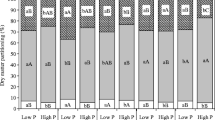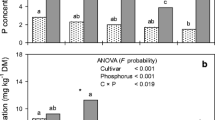Summary
In any study on the importance of phosphorus in potato production it is essential to recognize the fundamental significance of the phosphate esters in plant growth, particularly their role in the conversion of carbohydrates and in the metabolism of starch. In a recent article on the influence of phosphoric acid on the metabolism of plants published by Behrens and translated by Sauchelli (2), the statement was made that “Carbohydrates can enter into the metabolism of plants only by way of the carbohydratephosphoric acid esters. If as a result of phosphorus deficiency, the carbohydrates cannot be made use of. the plants stop building up secondary substances and may also lack energy for chemical synthesis and growth.”
The results of the present investigation have amply confirmed the need for phosphorus in the growth of the potato plant and in tuber development. Moreover, this need has been shown to be highly critical during the early stage of growth when normal meristem development and rapid vine growth are essential for a good crop. Evidence that relatively large amounts of plant phosphorus were needed for subsequent starch phosphorylation is supplied by the finding that tubers from 50-day-old plants contained only 23 per cent of the total plant phosphorus, whereas tubers from control plants, 112 days old, contained 83 per cent. Viewed from the standpoint of its importance in starch metabolism, the phosphorus contained in potato fertilizers has significance far beyond that heretofore fully recognized.
From the results obtained, which show clearly the fundamental need for phosphorus early in growth of the potato plant, it is understandable why potato yields can be expected to increase when a readily available form of phosphorus is applied to soils well supplied with residual phosphorus.
Similar content being viewed by others
Literature Cited
Arnon, D. I. and D. R. Hoagland. 1943. Composition of the tomato plant as influenced by nutrient supply in relation to fruiting. Botan. Gaz. 104: 576–590.
Behrens, W. U. 1956. Influence of phosphoric acid in the metabolism of plants. (Translated by Dr. Vincent Sauchelli) Agr. Chem. 11: 34–35.
Fiske, C. H. and Y. Subbarow. 1925. The colorimetric determination of phosphorus. J. Biol. Chem. 66: 375–400.
Gericke, W. F. 1924. The beneficial effect to wheat growth due to depletion of available phosphorus in the culture media. Sci. 60: 297–298.
Hawkins, A., G. L. Terman and O. L. Wyman. 1948. Efficient fertilization of potatoes in Maine. Maine Ext. Bull. 373, 16 p.
Houghland, G. V. C. 1950. An improved technique for growing potatoes in solution cultures. Am. Potato J. 27: 257–262.
Lyness, Arthur. 1936. Varietal differences in the phosphorus feeding capacity of plants. Pl. Physiol. 11: 665–688.
Nelson, W. L. and A. Hawkins. 1946. Response of Irish potatoes to phosphorus and potassium on soils having different levels of these nutrients. Res. Rpt. No. 79, U.S.D.A. Soil and Water Conservation Research Div. pp 1–12.
Ware, L. M. 1942. Residual effects of phosphorus on Irish potatoes in South Alabama. Proc. Am. Soc. Hort. Sci. 41: 265–269.
Author information
Authors and Affiliations
Rights and permissions
About this article
Cite this article
Houghland, G.V.C. The influence of phosphorus on the growth and physiology of the potato plant. American Potato Journal 37, 127–138 (1960). https://doi.org/10.1007/BF02855950
Accepted:
Issue Date:
DOI: https://doi.org/10.1007/BF02855950




